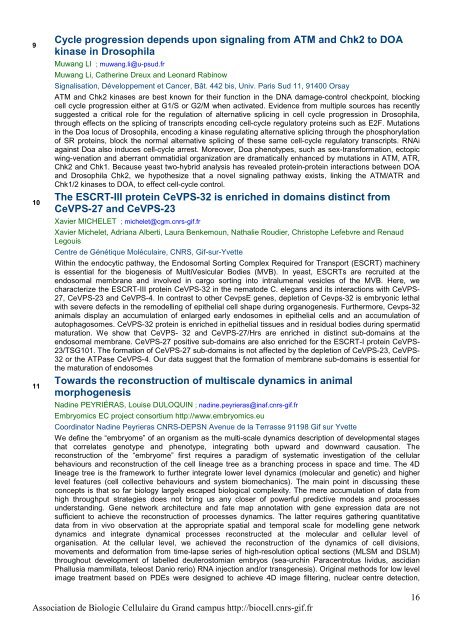Dynamique Cellulaire - Développement - Association de Biologie ...
Dynamique Cellulaire - Développement - Association de Biologie ...
Dynamique Cellulaire - Développement - Association de Biologie ...
You also want an ePaper? Increase the reach of your titles
YUMPU automatically turns print PDFs into web optimized ePapers that Google loves.
9<br />
10<br />
11<br />
Cycle progression <strong>de</strong>pends upon signaling from ATM and Chk2 to DOA<br />
kinase in Drosophila<br />
Muwang LI ; muwang.li@u-psud.fr<br />
Muwang Li, Catherine Dreux and Leonard Rabinow<br />
Signalisation, <strong>Développement</strong> et Cancer, Bât. 442 bis, Univ. Paris Sud 11, 91400 Orsay<br />
ATM and Chk2 kinases are best known for their function in the DNA damage-control checkpoint, blocking<br />
cell cycle progression either at G1/S or G2/M when activated. Evi<strong>de</strong>nce from multiple sources has recently<br />
suggested a critical role for the regulation of alternative splicing in cell cycle progression in Drosophila,<br />
through effects on the splicing of transcripts encoding cell-cycle regulatory proteins such as E2F. Mutations<br />
in the Doa locus of Drosophila, encoding a kinase regulating alternative splicing through the phosphorylation<br />
of SR proteins, block the normal alternative splicing of these same cell-cycle regulatory transcripts. RNAi<br />
against Doa also induces cell-cycle arrest. Moreover, Doa phenotypes, such as sex-transformation, ectopic<br />
wing-venation and aberrant ommatidial organization are dramatically enhanced by mutations in ATM, ATR,<br />
Chk2 and Chk1. Because yeast two-hybrid analysis has revealed protein-protein interactions between DOA<br />
and Drosophila Chk2, we hypothesize that a novel signaling pathway exists, linking the ATM/ATR and<br />
Chk1/2 kinases to DOA, to effect cell-cycle control.<br />
The ESCRT-III protein CeVPS-32 is enriched in domains distinct from<br />
CeVPS-27 and CeVPS-23<br />
Xavier MICHELET ; michelet@cgm.cnrs-gif.fr<br />
Xavier Michelet, Adriana Alberti, Laura Benkemoun, Nathalie Roudier, Christophe Lefebvre and Renaud<br />
Legouis<br />
Centre <strong>de</strong> Génétique Moléculaire, CNRS, Gif-sur-Yvette<br />
Within the endocytic pathway, the Endosomal Sorting Complex Required for Transport (ESCRT) machinery<br />
is essential for the biogenesis of MultiVesicular Bodies (MVB). In yeast, ESCRTs are recruited at the<br />
endosomal membrane and involved in cargo sorting into intralumenal vesicles of the MVB. Here, we<br />
characterize the ESCRT-III protein CeVPS-32 in the nemato<strong>de</strong> C. elegans and its interactions with CeVPS-<br />
27, CeVPS-23 and CeVPS-4. In contrast to other CevpsE genes, <strong>de</strong>pletion of Cevps-32 is embryonic lethal<br />
with severe <strong>de</strong>fects in the remo<strong>de</strong>lling of epithelial cell shape during organogenesis. Furthermore, Cevps-32<br />
animals display an accumulation of enlarged early endosomes in epithelial cells and an accumulation of<br />
autophagosomes. CeVPS-32 protein is enriched in epithelial tissues and in residual bodies during spermatid<br />
maturation. We show that CeVPS- 32 and CeVPS-27/Hrs are enriched in distinct sub-domains at the<br />
endosomal membrane. CeVPS-27 positive sub-domains are also enriched for the ESCRT-I protein CeVPS-<br />
23/TSG101. The formation of CeVPS-27 sub-domains is not affected by the <strong>de</strong>pletion of CeVPS-23, CeVPS-<br />
32 or the ATPase CeVPS-4. Our data suggest that the formation of membrane sub-domains is essential for<br />
the maturation of endosomes<br />
Towards the reconstruction of multiscale dynamics in animal<br />
morphogenesis<br />
Nadine PEYRIÉRAS, Louise DULOQUIN ; nadine.peyrieras@inaf.cnrs-gif.fr<br />
Embryomics EC project consortium http://www.embryomics.eu<br />
Coordinator Nadine Peyrieras CNRS-DEPSN Avenue <strong>de</strong> la Terrasse 91198 Gif sur Yvette<br />
We <strong>de</strong>fine the “embryome” of an organism as the multi-scale dynamics <strong>de</strong>scription of <strong>de</strong>velopmental stages<br />
that correlates genotype and phenotype, integrating both upward and downward causation. The<br />
reconstruction of the “embryome” first requires a paradigm of systematic investigation of the cellular<br />
behaviours and reconstruction of the cell lineage tree as a branching process in space and time. The 4D<br />
lineage tree is the framework to further integrate lower level dynamics (molecular and genetic) and higher<br />
level features (cell collective behaviours and system biomechanics). The main point in discussing these<br />
concepts is that so far biology largely escaped biological complexity. The mere accumulation of data from<br />
high throughput strategies does not bring us any closer of powerful predictive mo<strong>de</strong>ls and processes<br />
un<strong>de</strong>rstanding. Gene network architecture and fate map annotation with gene expression data are not<br />
sufficient to achieve the reconstruction of processes dynamics. The latter requires gathering quantitative<br />
data from in vivo observation at the appropriate spatial and temporal scale for mo<strong>de</strong>lling gene network<br />
dynamics and integrate dynamical processes reconstructed at the molecular and cellular level of<br />
organisation. At the cellular level, we achieved the reconstruction of the dynamics of cell divisions,<br />
movements and <strong>de</strong>formation from time-lapse series of high-resolution optical sections (MLSM and DSLM)<br />
throughout <strong>de</strong>velopment of labelled <strong>de</strong>uterostomian embryos (sea-urchin Paracentrotus lividus, ascidian<br />
Phallusia mammillata, teleost Danio rerio) RNA injection and/or transgenesis). Original methods for low level<br />
image treatment based on PDEs were <strong>de</strong>signed to achieve 4D image filtering, nuclear centre <strong>de</strong>tection,<br />
<strong>Association</strong> <strong>de</strong> <strong>Biologie</strong> <strong>Cellulaire</strong> du Grand campus http://biocell.cnrs-gif.fr<br />
16


